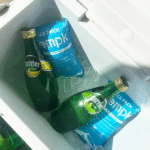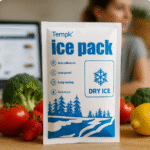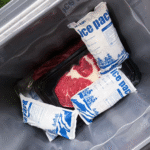عند شحن البضائع القابلة للتلف, maintaining a stable temperature is critical to ensuring product integrity. حزم الثلج الجاف, مصنوعة من ثاني أكسيد الكربون الصلب (co₂), offer a powerful solution to keep items frozen during transit. As the cold chain logistics industry evolves in 2025, understanding the latest regulations, أفضل الممارسات, and innovative trends in using dry ice for shipping is crucial for compliance and safety.
ماذا عبوات ثلج جافة للشحن?
Dry ice packs are sheets, كتل, or pellets of solid CO₂, designed to keep temperature-sensitive products at ultra-low temperatures. على عكس الجليد التقليدي, dry ice sublimates directly into gas without leaving behind any liquid residue. This feature makes it ideal for shipping items that require freezing, مثل الأدوية, عينات بيولوجية, and certain perishable foods.
Why Use Dry Ice for Shipping?
Dry ice packs are an excellent choice for shipping due to their unique properties, providing several advantages over traditional cooling methods.
-
قوة تبريد طويلة الأمد: Dry ice sublimates at a much slower rate than regular ice, ensuring your goods remain cold for longer durations.
-
No Moisture Runoff: Since dry ice does not melt into water, there’s no risk of water damage to sensitive items.
-
Ideal for Extended Transit: للشحنات التي تدوم أكثر من 48 ساعات, dry ice is often the preferred choice for keeping goods frozen.
2025 Regulations for Shipping Dry Ice
Shipping dry ice is subject to strict regulations due to its classification as a hazardous material. في 2025, the following key regulations must be adhered to when shipping dry ice:
-
رقم الأمم المتحدة: Packages containing dry ice must be clearly labeled with the UN number “1845.”
-
فصل 9 تسمية الخطر: فصل 9 hazardous materials label must be affixed to the package.
-
إعلان الوزن: The net weight of dry ice in kilograms must be marked on the package.
-
متطلبات التنفيس: Packaging must allow CO₂ gas to escape to avoid pressure buildup during sublimation.
للنقل الجوي, الاتحاد الدولي للنقل الجوي (IATA) limits the amount of dry ice per package to 2.5 kg on passenger aircraft and up to 200 كجم على رحلات الشحن.
Best Practices for Using Dry Ice Packs in Shipping
To ensure the safe and efficient use of dry ice for shipping, اتبع أفضل الممارسات:
1. حدد العبوة المناسبة
-
حاويات معزولة: Use insulated coolers or Styrofoam containers to maintain the desired temperature.
-
تغليف التهوية: Ensure the container has ventilation holes to allow CO₂ gas to escape during sublimation.
-
Cushioning: Properly secure items inside the packaging to prevent damage during transit.
2. Calculate the Amount of Dry Ice
Determine the quantity of dry ice based on the transit duration and the perishability of the goods. A common guideline is to use 2.5 كيلوغرام من الثلج الجاف لكل 24 ساعات الشحن.
3. تسمية الحزم بشكل صحيح
-
Mark the package clearly with “الجليد الجاف” أو “ثاني أكسيد الكربون, صلب.”
-
نعلق رقم الأمم المتحدة (1845) و فصل 9 تسمية الخطر.
-
Specify the net weight of dry ice in kilograms.
أخطاء شائعة لتجنب
-
Sealed Containers: Never use airtight containers to pack dry ice; this can cause dangerous pressure buildup.
-
وضع العلامات غير الصحيحة: Ensure all required labels are attached to avoid delays or rejections by shipping carriers.
-
Exceeding Weight Limits: Stick to the weight regulations to prevent violations of hazardous materials rules.
بدائل للثلج الجاف
بينما الثلج الجاف فعال, several alternatives may be more suitable depending on your shipment requirements:
-
حزم هلام: Reusable and non-hazardous, ideal for shorter transit times.
-
مواد تغيير المرحلة (PCMS): These materials maintain specific temperature ranges and are reusable, offering a more sustainable option.
-
حزم الثلج التقليدية: While cheaper, ice packs can leave water residue, البضائع التي يحتمل أن تضر.
Sustainability and Trends in Dry Ice Shipping
في 2025, several emerging trends are shaping the dry ice shipping industry, focused on both environmental sustainability and technological advancements.
1. الإنتاج المستدام للثلج الجاف
Many suppliers are shifting toward environmentally friendly production methods by capturing CO₂ from industrial processes, such as ammonia synthesis, reducing the overall carbon footprint of dry ice.
2. حلول التعبئة والتغليف الهجينة
Hybrid solutions combining dry ice and PCMs are gaining popularity. These packouts minimize CO₂ use while extending the cooling duration, making them more eco-friendly.
3. Smart Packaging and Tracking Technology
Innovations such as smart CO₂ sensors and QR-coded labels allow for real-time tracking of dry ice and product temperatures, ensuring better monitoring and compliance.
How to Store Dry Ice Packs for Shipping
Proper storage is essential to maximize the shelf life and effectiveness of dry ice packs:
-
تخزينها في حاوية معزولة: Use coolers or specially designed containers to slow sublimation.
-
تجنب الحاويات المختومة: Never store dry ice in airtight or sealed containers; تأكد دائمًا من التهوية المناسبة.
-
مراقبة معدلات التسامي: Keep track of the rate at which dry ice sublimates to ensure the correct temperature is maintained.
Frequently Asked Questions About Dry Ice for Shipping
س 1: كم من الوقت يستمر الجليد الجاف أثناء الشحن?
يمكن أن يستمر الجليد الجاف بين 18 ل 24 hours depending on the type of packaging and external conditions. Blocks of dry ice last longer than pellets.
Q2: Is dry ice safe to ship?
نعم, dry ice is safe for shipping when packaged according to safety guidelines, including proper ventilation and labeling.
س 3: هل يمكن استخدام الثلج الجاف لشحن المواد الغذائية?
نعم, dry ice is commonly used for shipping frozen and perishable foods, as long as the necessary safety measures are followed.
الخلاصة والتوصيات
Dry ice packs are a powerful tool for shipping temperature-sensitive products in 2025. By choosing the right supplier and adhering to best practices for packaging, تخزين, والسلامة, يمكنك التأكد من وصول منتجاتك إلى وجهتها في حالة مثالية.
خطة العمل:
-
تحديد نطاق درجة الحرارة المطلوبة لشحنتك (المجمدة مقابل البرد).
-
احسب الكمية الصحيحة من الثلج الجاف على أساس مدة الشحن.
-
Verify regulatory compliance and ensure proper packaging and labeling.
-
Consider hybrid packaging solutions to improve sustainability and cost-efficiency.
حول Tempk
Tempk هي شركة رائدة في مجال توفير حلول التعبئة والتغليف لسلسلة التبريد, offering high-quality dry ice and other thermal control products to ensure the safe and efficient transport of temperature-sensitive goods. We specialize in helping businesses optimize their logistics while adhering to all relevant safety and regulatory standards.
اتصل Tempk اليوم to learn more about our dry ice solutions and how we can help streamline your cold chain shipments.























